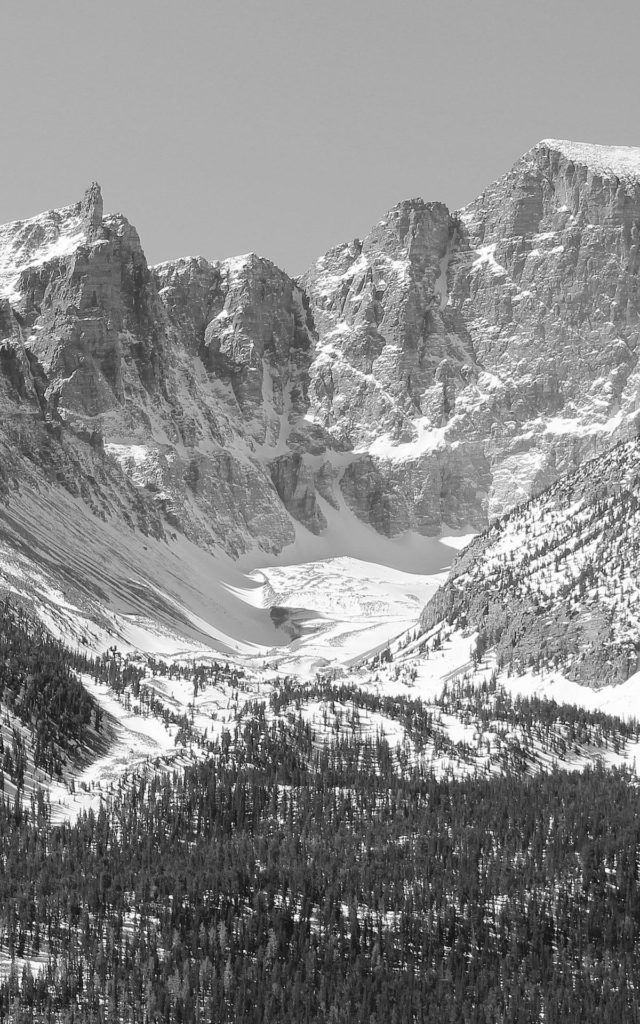
Vamoose

Great Basin National Park is a wonderful place to visit during the winter. GBNP is small enough to be appreciated in one or two days, and yet, the Great Basin is so vast and mysterious that you can’t help but feel that after you have left, no matter for how long you have stayed, you will have left missing out on so much.

Great Basin National Park is the home to 4,000-year-old bristlecone pine trees, Wheeler Peak Glacier, the last glacier in Nevada, and the Two Sisters, Stella and Teresa, and their little brother Blue.

Great Basin National Park is about a four-hour drive from Las Vegas or Salt Lake City. It’s about a six-hour drive from Reno.

Baker, Ely, and Delta are the nearest towns to GBNP. Most of sleepy Baker, pop. 68 and right outside of the park, is closed during the winter.
Reclaimed from the desert, Delta, pop. 3,400, is a farming and dairy community and is about 100 miles east of GBNP.
And, Ely, pop. 4,000 and 50 miles west of GBNP, is an old mining town. Ely has just about every comfort anybody could ever need. They have about a dozen motels, plenty of restaurants, and a movie theater.

You’ll want to plan your winter visit by checking the weather forecast and SNOTEL’s interactive map for current snow depth on Wheeler if you’re planning to visit early or late in the season. You won’t want to drive up there only to find out the roads are closed or require snow chains on some of the mountain passes.
I was leaving GBNP once and parked on the side of the road to take a Power Nap, when I woke up it was snowing quite heavily, it took me forever to get to down to Caliente!*

If you drive to the GBNP at night, be warned of the crazy* jackrabbits. They easily panic and will sprint right in front of you when you least expect them. If you have to drive at night, slow down and honk your horn whenever you see them.

The only camping at GBNP during the winter, as of late 2015 and early 2016, was at Lower Lehman Campground and Strawberry Creek. The Lower Campground has spaces for eleven, and Strawberry Creek has spaces for eight. First come first served, they usually get filled up by nightfall on any day of the week.
Upper Lehman Campground, with many more spaces, is closed due to renovations. They’ll remain closed until the spring of 2017. And as of August 2016, Strawberry Creek will most likely be closed because of a fire caused by lightning. But don’t let that discourage you from camping, because there are other places to camp just outside of the park.
A little rustling, a little faint sound, I went towards the commotion and found the little cold creek next to the camp.*

If you plan to try your luck and camp in GBNP, get there early, and while you’re still in Baker, keep an eye out for signs selling bundles of firewood. On the coldest of starry nights, nothing is better than hot chocolate, marshmallows, and a warm fire, remembering the hundreds of airplanes flying in from the East like a leaky faucet until they all of a sudden stopped around midnight.*
Other campfires, other nights and places, I’d stir and maintain the fire until the very last ember went out, like a final, one last thought.*

During the winter, the minimum you’ll need to explore GBNP for a day are mountain terrain snowshoes, snow boots, snow poles, snow gaiters, a knife, parachute cord, flashlight, some grub, water, winter clothing, and UV sunglasses. A light/day backpack.* You’ll also want to do your homework on winter hiking.
Let someone know about your hike and when you plan to return. If you don’t check in they can send recue.*

The hike, up to the Bristlecone Grove, Wheeler Glacier, the Two Sisters, and Blue, is about eight to eleven miles round trip and can be done in a day. Mostly moderate but sometimes strenuous on some of the forty-five degree climbs, the hike, after passing the Red Meadow, can be dangerous, especially if you’re out of shape, don’t come prepared, and/or you have a medical condition. But don’t let that stop you from coming to Great Basin National Park altogether during the spring, summer, or fall. Visiting near the end of fall is especially colorful.
I’m not sure about snowshoeing the road up to Wheeler during the winter. I think its 10 miles from the Visitor Center, 20 miles round trip. They got it closed off and I’m not sure if you can park close to it. But it’ll be easier on my left knee*

Gangs of ornery turkeys are often preparing to sunbathe early in the cold mornings on the roads and campgrounds in GBNP. They can be found all over GBNP. In the lower elevation forests of the park is where you’ll find them during the winter. Word is, the turkeys escaped years ago from a hunting ranch. They all have been fugitives ever since.

To get to the beginning of the trail, you’ll have to walk west through the Upper Campground. You usually won’t need to wear your snowshoes for the first mile and a half of the trail.

If you have time on the way back, just before nightfall, the haunted campground is a good place to wander around, following the strange arborglyphs, across the creek, up and over towards the old ponderosas and owl pictoglyphs.

When you reach the Osceola Ditch, about a half a mile from the beginning of the trail, follow the ditch to the left for about 100 feet.

The Red Meadow is the next place of interest after leaving Osceola. This is the place where you first get a good view of Wheeler. Northwest of Wheeler are the cirque, glacier, and bristlecones. The Two Sisters are to the right of Wheeler, on the other side of the Awry Arete.

After the Red Meadow, you’ll want to hurry past Lull Spring.
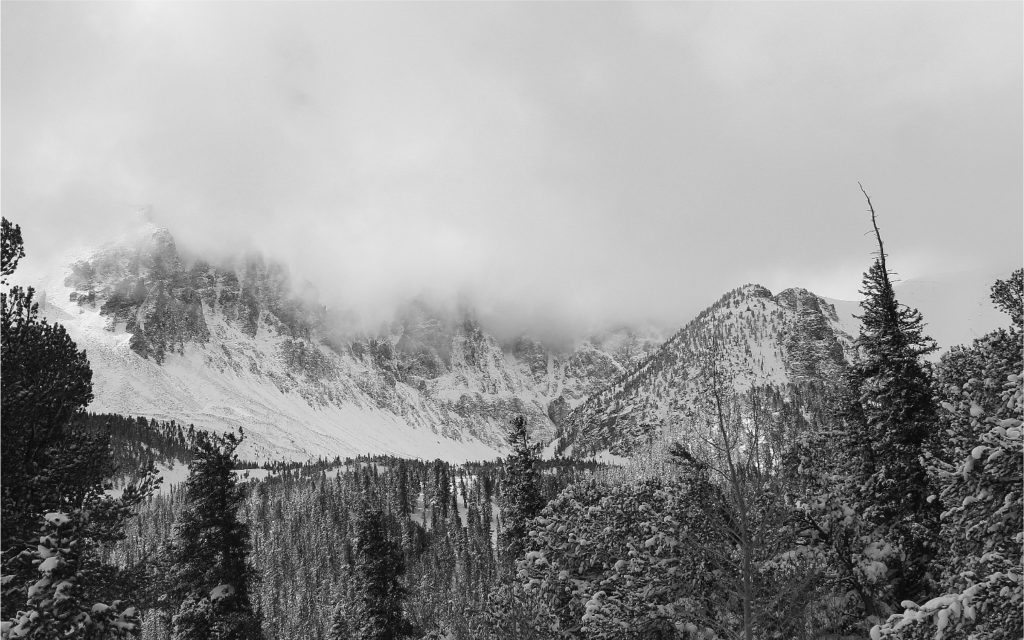
When you reach the Zig, after leaving Lull Spring, more often than not, snow will have covered up the trail. From here on forward, you’re on your own. You’ll have to rely on the sun, landmarks, or/and a compass for navigation. Doing some homework about basic navigation and GBNP will pay off here. The park is small enough with many visible landmarks that it’s highly unlikely that you’ll ever get lost or be unable to follow your snow tracks back out. But that doesn’t mean that you can’t get lost or that the GBNP isn’t dangerous. The weather can quickly change, or you can become injured or disorientated.

From the Zig, continue west for another half a mile or so until you reach Wheeler Peak Campground. The half mile climb is strenuous, sometimes a little over forty-five degrees.

Wheeler Peak Campground is a good place to stop and rest for a while. The snow depth here can be anywhere from two to five feet. Probably more.* The campground has several large meadows. Make it over to one of them, and you’ll get a good view of Wheeler and the Sentinel.
From the campground, Wheeler is south towards the high noon sun, and the Sisters are west, where the sun goes to die.

To visit the cirque, bristlecones, and glacier, you have two choices. You can either go south and beeline straight over the Wall towards Wheeler, or you must circumvent the Wall, by slowly traversing your way left and up until you get past the Wall. After you’re over the Wall, follow the moraine up to the cirque, bristlecones, and glacier. Either way, be alert for small avalanches!
If you want to visit the Two Sisters, continue west from the campground towards the mountain pass between Wheeler and Baldy Mountain.

If you want to visit them all, start by visiting the Sisters first.

If you only got one whole day, I recommend you take your time and visit the cirque, bristlecones, and glacier, and save the Sisters for another day. You could hurriedly visit the cirque, bristlecones, glacier, and the Sisters in a day, but you better make sure you hurry down before nightfall!
I usually started my hikes while still dark 3 or 4AM, and ended them too, 9PM or later. Days are short. New Moon and Moonlight walks. *

When you leave, you could leave the same way you came up by following your snow tracks out, or you can take another way. From the Bristlecone Grove and Blue, keep following the moraine down east-northeast until you arrive.
Detours

When going on detours, many arguments can be made for and against spontaneity. In the tilting limestone of GBNP, there are dozens and dozens of caves, but most are hidden, inaccessible, and unexplored. One cave that is accessible is Lehman Caves. Even during the winter, the tours are usually sold-out, so be sure to make your reservations well in advance. The Talus Room is the largest of all the rooms in the cave, but has been off limits since the 80’s after too many complaints.
Orchard. One or two bags of sticky pinion nuts.*

After the cave tour, don’t forget to hike the short Mountain View Nature Trail to see the nature cave entrance. As you pass over the skeletons of the Far Past and through violet prickly cactus, emerald sagebrush, and a whirling pinyon and juniper forest, you can’t help but let your imagination wonder about the Far Past, Far Future, and Right Now!
Like arguments no longer questioned or doubted.*

Not all stars look alike. Most stars look like twinkling candles on a big ol’ birthday cake, but a few look fuzzy or look like smudges. They say those anomalies are comets, nebulae, clusters, and galaxies. With some 7X50 binoculars, how many Messier objects can you find in one night?
The Ranching Exhibit, on Highway 488, halfway between Baker and GBNP, is a good place to picnic and stargaze whenever there is a new moon.
What exactly is Andromeda. A smudge. Faint Light. Moving on after a minute or two. Long Before, Long After. Another sort or kind of object permeance.*

And there’s so much more to explore close by:
Baker and Johnson Lakes and Mines. Baker Lake is an overnighter 😬*
Wheeler Summit Trail and the Mysterious Cairns,
Grey Cliffs and the Strange Lower Pictograph Caves,
Lexington Arch,
Silver Creek and Reservoir, Nevada
The Clock of the Long Now,
Baker Archaeological Site and the Lost Child,

Great Basin Visitor Center in Baker,
Sacramento Pass and the Snake Range.
FCFS camping with a little pier and quaint pond, cattails; I think I read they even stock it with rainbows; Nice skies at night but still freezing cold in March/April.*
Osceloa and the Black Horses,
Rose Guano Cave and Arch,
Skull Rock Pass, Utah
Confused Range and Fossil Mountain,
Fort Deseret State Park,
Black Rock and Spring, and the Snowflake Obsidian,

Clear Lake Water Management Area, Utah and 3,000 miles,
Black Rock Desert Volcanic Field,
Sunstone Knoll, Utah,
Topaz War Relocation Center,
Strawberry Creek and Campground, NV,
U.S. Route 50, The Loneliest Road in America,
Wah Wah Mountains and Crystal Peak,
Frisco, UT, the craziest town in the Great Basin,

Great Basin Museum, Utah
Drum Mountain, UT and the Bombs,
Antelope Springs and the Trilobites,
Windmills on U.S. 50,
Major’s Place and Fluorescent Calcite,
Nevada Swamp Cedar Natural Preserve,
Swasey Mountain, Utah and the Wild Horses,

Fish Springs National Wildlife Refuge and the Pony Express,
Cave Lake State Park and Rainbow Trout,
Ward Charcoal Oven Historic State Park,
Ely Elk Viewing Area,
Garnet Hill Recreational Area,
White Pine Public Museum and Library,
Nevada Northern Railroad Museum,
Topaz Mountain and Apache Tears,

Ward Mountain Recreation Area,
Lunar Crater National Natural Landmark,
Ruby Mountains and Roads End,
Cathedral Gorge State Park,
Pioche.*
Snow Canyon.*
St. George.*
Duck Creek.*
The Lost City, NV.
Skull Valley Goshute Reservation,
Mount Moriah Wilderness Area and the Infinite Mesa.
Hodgepodges, Farragos, Medleys, and Gallimaufries

Make your visit more fun and play the Great Basin Scavenger Hunt. Prepare a list, any kind of list, after doing your homework on the GBNP, for example: Find a single-leaf pinyon tree and a juniper tree berry; find some quartzite, shale, and limestone; find a pine cone from a ponderosa pine tree; smell the crushed leaves from a sagebrush and the flowers from an Indian paintbrush; splash water on your face from Blue Lake; and, take a picture of a baby bristlecone pine tree.

The pygmy rabbits of the Basin are the smallest rabbits in the world. The Basin’s mountain lions and black bears are the loneliest. The rattlesnakes are the orneriest. And, the yellow-belly marmots are the laziest!
I was surprised to learn yellow-bellies can hibernate for up to 9 months. I like the sound of that!*

Learn to dread the shivering from hypothermia, because confusion and amnesia are real and near. Turn around and get off the mountain while you still can and try again another day. Always be sure to check the weather, eat a hearty breakfast, and dress appropriately whenever going out into the cold. They say prevention is the best medicine.
If you’re close to hypothermia don’t stop moving, even if that means walking around in small circles.*

Quartzite is the oldest and hardest of the three main kinds of rocks found in the GBNP. Shale and limestone are the other two. Find all three and compare them as you hike, noting where you find the majority of each kind.
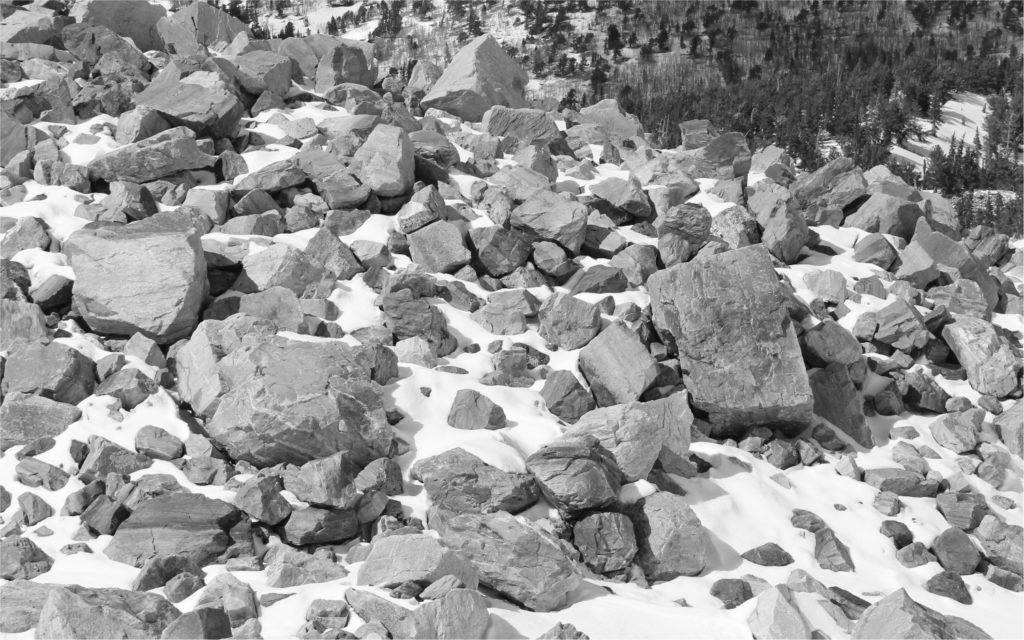
Toiyabe means mountain, and Nevada means snow-covered. Did you know Nevada is the land of snow-covered mountains?
I didn’t. They mostly run from North to South.*

When you hike up to Wheeler, try to notice where one kind of tree disappears, like the pinyons and junipers, and where another kind appears, like the limber pines.
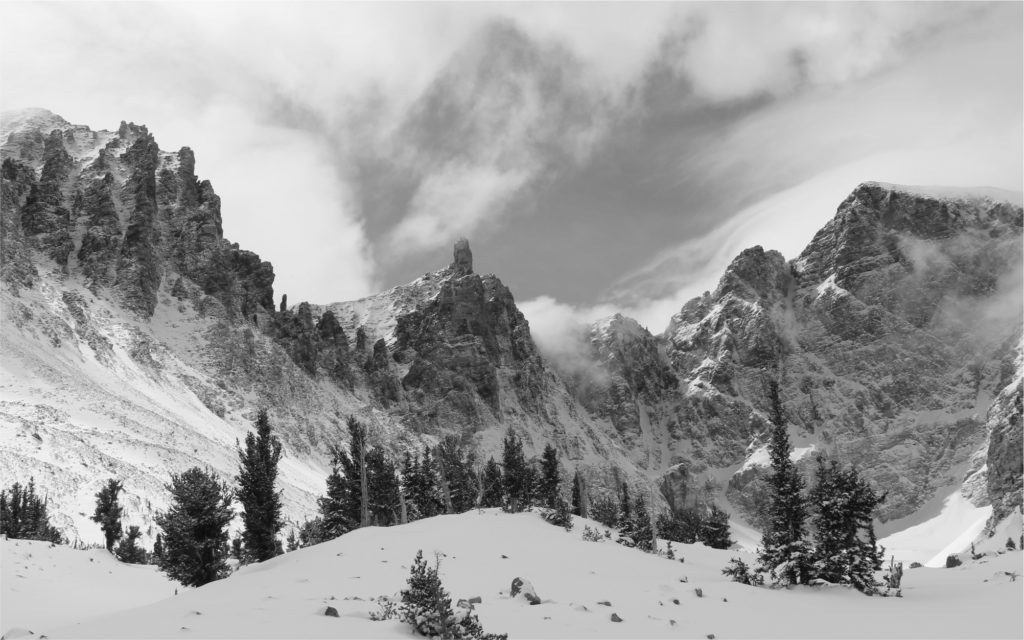
Try spending less time taking pictures and more time concentrating and memorizing, focusing on colors, size, shapes, light, smells, touch, sounds, features, feelings, and questions.
I need to work more on following my own advice.*

Strata of limestone, sometimes thousands of feet thick, are made up from the lithified remains of ancient sea creatures! How strange to have millions and millions of years of stability, as skeletons silently fall through the water, day after day, layer after layer, quietly buried and compressed, only to be violently uplifted and then actively eroded into cities and caves, mountains and highways.

Be quiet and still. Feel the fire inside and wintry outside.

A person can usually walk two to three miles every hour. And a person can usually read about 12,000 to 18,000 words per hour. Doing your homework and preparing for your trip are good and easy ways to be sure that you don’t miss out on any clues or signs.

Whenever you stop to rest, close your eyes for a while, remember, and visualize, the journey, the destination, or try to remember and visualize nothing, waiting for . . . to appear.
I’m getting to like about not worrying about where I’m not and only worrying about where I am.*

As I wandered around and around the dozing cirque, a colorless bristlecone pine tree appeared and told me to shh, be still and listen, “for every sad day, remember a good day.”

Both the blue pinyon jays and Clark’s nutcrackers like to gather and store tens of thousands of pine cone seeds every season. They cache anywhere from three to ten seeds in thousands of different locations. They don’t like to keep all their seeds in one basket.
I saw a nutcracker up there before flying off. Didn’t see any blue jays.*

Shale and fossils are made up from the weathered remains of rocks that have been carried down by rivers from the top of old mountains and deposited onto deep ocean floors. There, they are compressed, sometimes along with skeletons, and then moved and tilted to other sides of the world until they are slowly uplifted and reappear again on top of new mountains. Almost two miles above sea level, lots of shale is found on Wheeler Peak Campground! What art projects can you make out of shale for someone special?

Play the naming and matching game: Give whimsical names to unfamiliar trees, plants, rocks, landmarks, birds, and animals, you see once or time and time again.

Wheeler and the Sentinel are made up from the detritus of many dead mountains.
of many dead creatures. But exactly how many?*
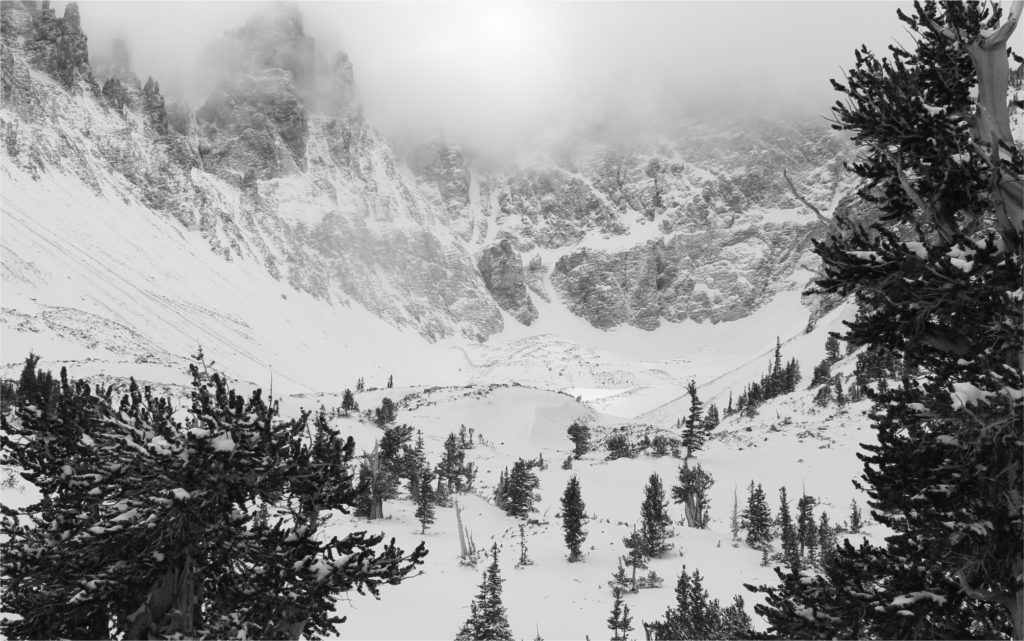
Moonlight hikes are eerie. Start early in the morning around 3 or 4 a.m., and use a flashlight with a red filter sparingly. If you get lost and disorientated, stop and wait for the sun and don’t and push on.

Seek your Spirit Tree and promise to return, in this life or the next. The next.*
[mental snapshot: first time, I hiked on until I came up on slippery ice on the trail with a 25 foot strait drop-off. I turned back and thought I could return with a shovel and snow cleats. I did and got past that point but when I got up even higher, new challenges, waist and chest high snow. So I left again. And returned with snowshoes.* ]
Find the Great Basin and Buenaventura River on old maps. Unreachable, uninhabitable, and unexplored, the GBNP is near the center and hard to get to. How many mountains and springs are there in the Great Basin? Too many to count, that’s how many!
[Snapshot: So the got great dark skies for seeing the stars and I was under the impression for the longest time and planned my trips around, the new moon, but I learned the moon doesn’t need to be new to have good views, a little sliver won’t hurt at all. I conjecture most of the light pollution comes from being too near cities not a few days before or after the new moon light. I’m going to have to go up there more often. I heard them before I saw them soaring across the sky before they were gone, two owls.*]
Fiery Volcanoes, Snowy Sea Shores, Sleepy Mountains, and Moments of Warm Sunlight.
[Snapshot. So they still got a lot thermo activity underground I’ve read. Over a dozen free hot springs. I went to one off of US 50. Or was it in Utah? I don’t recall right now, but I’d wish it was during the winter, too many flies. Utah.*]
Here’s a riddle. Who is furthest away from you and yet the closest? You’ll never catch up, and never leave behind*?
[Snapshot: I’m familiar with Pinion and Juniper trees. Aspen. Ponderosa. Bristle. Other Higher Elevation trees not so much. I did study one, suppose to be limber and I remember testing one, and it was but I forget what it was called. Limber Pine, duh.*]
Ghostly and gray, aspen trees are found everywhere in the park. Their long past summer’s leaves continue to tremble in the slightest of snowy breezes.
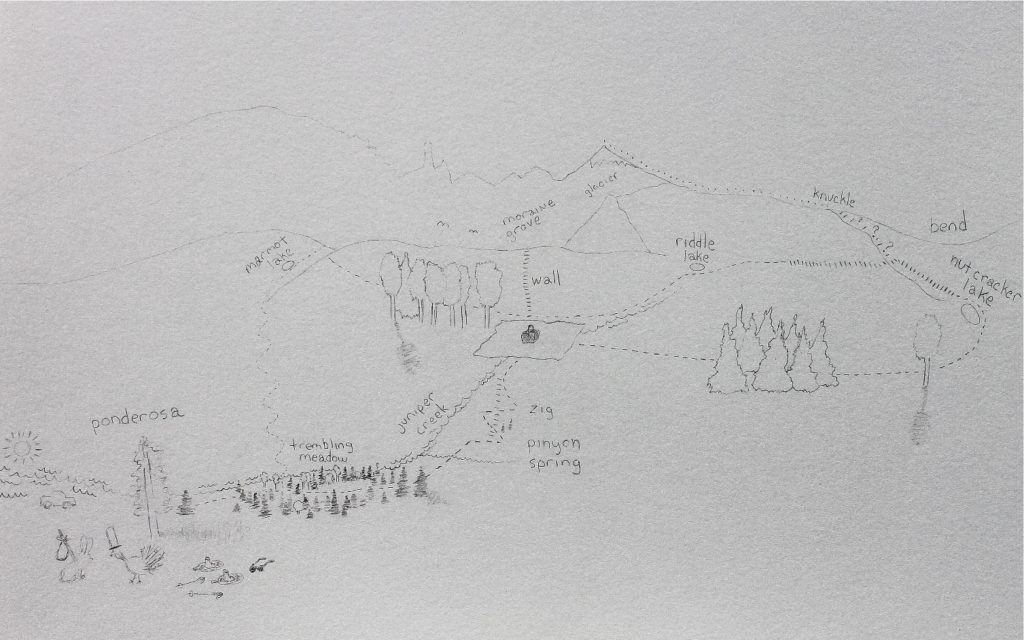
The Orion Nebula rises every winter, returning from the east of infinity, time after time, like an old friend with the best of news.
Nebula*
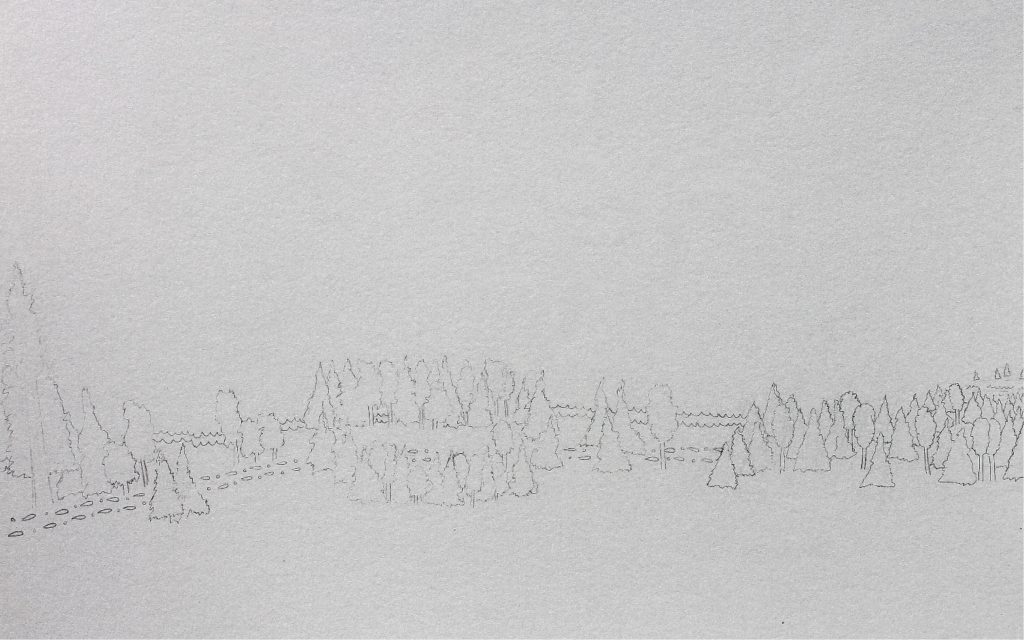
Some remembered, most lost and forgotten, the men, women, children of Nevada are a crazy quilt of Native Americans, Explorers, Missionaries, Soldiers, Pioneers, Miners, Cowboys, Farmers, Wanderers, Desperadoes, Gamblers, Artists, Scientists, Townsfolk, and Dreamers, each contributing to the enduring history and future of Nevada, the Land of Snow-Covered Mountains.
[Snapshot: Silence and Summers from long ago. Snow covering picnic tables and grills. Brief moment before all the ice melts again. *]
The End of Winter
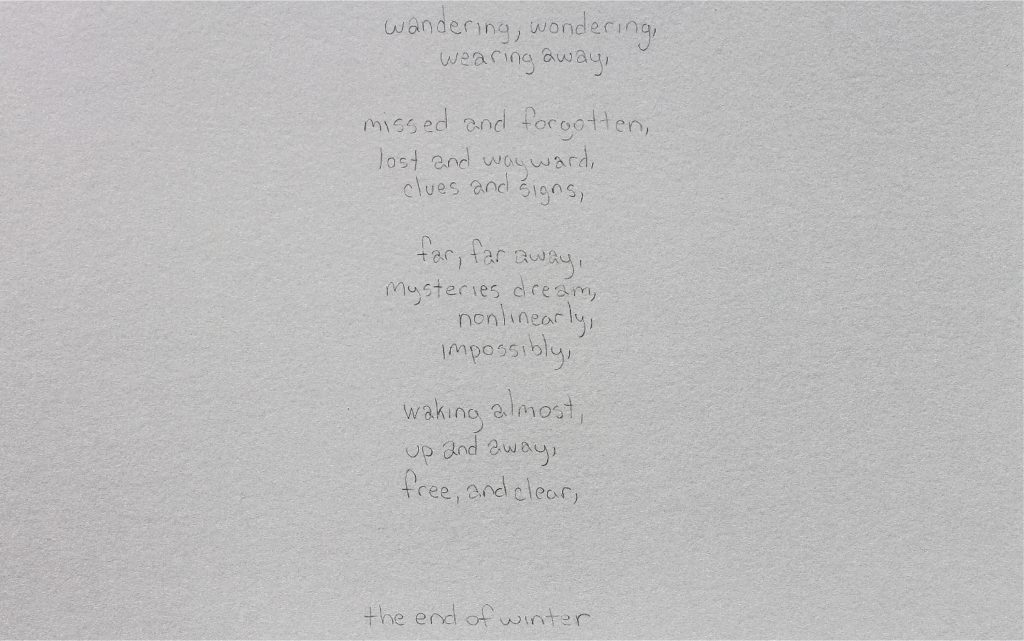
wandering, wondering,
missed and forgotten,
lost and wayward,
[56]
lulling, pass away,
snowflakes and yesterdays,
blue and ado,
[57]
pathless, impassable,
nonlinearly, impossibly,
[58]
far and free
wandering, wondering,
wearing away,
missed and forgotten,
lost and wayward,
clues and signs,
far, far away,
mysteries dream
nonlinearly,
impossibly,
waking almost,
up and away,
free, and clear,
the end of winter.
Leaving
wondering.
far away from cauldrons.
far away from shifting sands.
spiraling,
out of control,
the end of winter.
far away from spiraling cauldrons.
far away from the shifting sands.
far far away from tomorrow’s after.
mysteries dream nonlinearly,
waiting for the end of winter.
(Day 2)*
clues, shifting snow
(Year 2043)*
water and
river water, never ending
never end
leaving, almost awaking up again
Hidden within the refuges
Hidden within the refuges
the end of winter. far away from the spiraling cauldrons of pain and fear, anger and despair. faraway from the shifting sands of light and shadows, revelations and regrets. faraway from tomorrow and ever after. Mysteries sleep and dream nonlinearly. Every now and then, when no one is around, among strange forces, bending and warping the earth and sky, far far away Mysteries stir as if they were about to wake up again.
the end of winter.
far away from spiraling cauldrons
far away from shifting sands
far away from tomorrow after
Mysteries dream nonlinearly
the end of winter.
far away from the spiraling cauldrons
far away from the shifting sands
[Full pictures; with text in between on black paper
memories are in black and white.] Deleted*
wandering, wondering,
wearing away,
missed and forgotten,
lost and wayward,
clues and signs,
far, far away,
mysteries dream
nonlinearly,
impossibly,
waking almost,
up and away,
free, and clear,
the end of winter.
Leaving
wondering.
far away from cauldrons.
far away from shifting sands.
spiraling,
out of control,
the end of winter.
far away from spiraling cauldrons.
far away from the shifting sands.
far far away from tomorrow’s after.
mysteries dream nonlinearly,
waiting for the end of winter.
(Day 2)*
clues, shifting snow
(Year 2043)*
water and
river water, never ending
never end
leaving, almost awaking up again
Hidden withing the refuges
Hidden withing the refuges
the end of winter. far away from the spiraling cauldrons of pain and fear, anger and despair. faraway from the shifting sands of light and shadows, revelations and regrets. faraway from tomorrow and ever after. Mysteries sleep and dream nonlinearly. Every now and then, when no one is around, among strange forces, bending and warping the earth and sky, far far away Mysteries stir as if they were about to wake up again.
the end of winter.
far away from spiraling cauldrons
far away from shifting sands
far away from tomorrow after
Mysteries dream nonlinearly
the end of winter.
far away from the spiraling cauldrons
far away from the shifting sands
Full pictures; with text in between on black paper
memories are in black and white
passes all too soon,
refuges and refugees,
Refuges
Sorrow
regret
Revelations
Another Kind, another Sorts of Object Permanence.*
* 2024